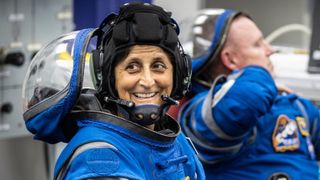
NASA astronauts Suni Williams (left) and Butch Wilmore, the first people to fly on Boeing Starliner, are the two astronauts of Crew Flight Test. Here they are pictured during a launch dress rehearsal on April 26, 2024.
(Image credit: NASA/Frank Micheaux)
Two NASA astronauts are days away from partaking in a new spacecraft’s first-ever human launch — if schedules hold, that is.
Boeing Starliner’s debut crew, Barry “Butch” Wilmore and Suni Williams, told reporters on Wednesday (May 1) that their test pilot experience with the U.S. Navy will help them assess the spacecraft during its debut crewed launch. Liftoff is currently set for Monday (May 6) at 10:34 p.m. EDT (0234 GMT May 7). The event will be livestreamed here at Space.com, via NASA Television.
“It almost feels unreal,” Williams, who will serve as the mission pilot, said of the launch date during a livestreamed press conference at NASA’s Kennedy Space Center. The discussion was conducted remotely because both Williams and Wilmore are currently quarantining for the impending journey.
Williams’ sentiment is due to the fact she has been in line for nearly a decade, waiting to snag a spot on a commercial crew flight; her original assignment to the related NASA program came in 2015 because of her expertise with spacecraft development. Her slot on this mission, Crew Flight Test (CFT), came in 2022. For his part, Wilmore has been in the program queue since at least 2019, initially selected as a backup for the mission before being reassigned to the CFT prime crew in October 2020.
At last, CFT appears to be within reach. Its historic liftoff will mount the duo atop the United Launch Alliance (ULA) Atlas V rocket — another first for humans. The following week or so will include numerous tests of Starliner and a brief visit to the International Space Station (ISS).
Related: 2 astronaut taxis: Why NASA wants both Boeing’s Starliner and SpaceX’s Dragon
Wilmore, 61, and Williams, 58, have at least 11,000 hours of collective flight experience behind them, much of it in high-performance jets. They are also both veterans of NASA’s space shuttle and Russia’s Soyuz spacecraft programs, have served as long-duration astronauts on past ISS missions, and have spent decades of time as trainers and supports for other astronauts besides.
Breaking space news, the latest updates on rocket launches, skywatching events and more!
“Well goodness, that’s really the reason that we are here,” Wilmore said when Space.com asked how the duo’s test pilot experience helped with Starliner’s development and preparation for CFT’s checkouts in orbit. Both Wilmore and Williams are veterans of the prestigious U.S. Naval Test Pilot School, and Wilmore said an exchange he had with the U.S. Air Force Test Pilot School has prepared him for this moment as well.
“That background of understanding test acquisition was required to certify various components … [and] the vital importance of making sure that in an integrated fashion, everything works as planned. That’s been invaluable for the process,” Wilmore said of bringing his piloting work to bear on Starliner’s development. Still, he noted that decades ago, “I don’t think either one of us ever dreamed that we’d be associated with the first flight of a brand-new spacecraft.”
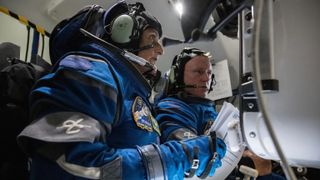
NASA astronauts Suni Williams (foreground) and Butch Wilmore wearing Boeing spacesuits in the Starliner spacecraft simulator at NASA’s Johnson Space Center during emergency training on Nov. 3, 2022. (Image credit: NASA/Robert Markowitz)
Having accrued thousands of hours in cockpits to evaluate high-performance aircraft, the astronauts have an instinct about the right types of questions to ask about spacecraft capabilities — for instance, why displays are showing certain kinds of information. Their experience especially has implications for understanding crucial safety maneuvers. As Williams puts it: “How is that [information] going to help me? How is that going to lead me down a wrong path, or right path?”
Manual flying, of which CFT will feature plenty to certify Starliner for future contingencies, is another reason these astronauts are on board. Aside from its extensive automatic systems, Starliner features both a rotational hand controller and a translational hand controller. These controllers are similar to what the crew has been fully entrenched with from “day one of Test Pilot School,” Williams said. As such, the naval aviators can evaluate the spacecraft’s handling qualities and work alongside ground teams to make sure the procedures aren’t just working, but working well.
The astronauts also aim to ensure that what they see on the ground, during simulations, represents what they’d see during the real-life mission. Questions they ask in the simulator, Wilmore emphasized, include the following: “If you’re testing a couple of boxes that are integrated together, what are those boxes? Are those boxes representative of what we have in the spacecraft? What’s the firmware in those boxes?” Answering those questions are important to make sure “the test is representative of what the spacecraft is on orbit.”
Related: I flew Boeing’s Starliner spacecraft in 4 different simulators. Here’s what I learned (video, photos)
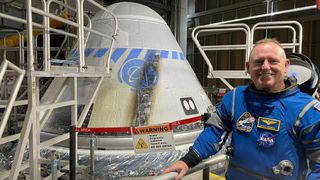
Butch Wilmore, commander for Crew Flight Test, outside the Boeing Starliner spacecraft during a dress rehearsal on April 26, 2024. The scorch mark on the side of the spacecraft is a harmless souvenir from re-entry during an uncrewed mission known as Orbital Flight Test, in 2019. (Image credit: Mike Fincke/NASA/X)
The CFT astronauts’ experience will come to the fore as Boeing seeks to join SpaceX as a regular supplier of astronaut spacecraft for long-duration stints to the ISS. Both companies received billion-dollar-scale contracts from NASA in 2014 for commercial crew missions.
Boeing’s contract for Starliner is valued at $4.2 billion in 2014 dollars, compared to SpaceX’s $2.6 billion. (Soyuz also continues to send some NASA astronauts aloft for policy and backup reasons, under separate NASA funding.)
SpaceX flew its first test Crew Dragon astronaut flight in 2020; 11 operational ones to ISS swiftly followed. Boeing, however, required extra time and testing. The first uncrewed Starliner test flight in 2019 failed to reach the ISS as planned after software glitches stranded the spacecraft in the wrong orbit. The second attempt in 2022 got to ISS safely, however, as dozens of implemented fixes solved the issue.
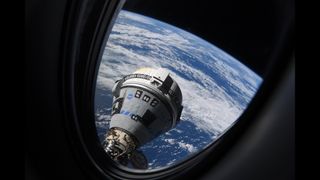
Boeing’s Starliner space capsule docked at the International Space Station for the first time, during an uncrewed test in 2022. (Image credit: ESA)
CFT was then expected to fly last year, but was delayed by several months because new technical problems arose. The suspension lines of Starliner’s main parachutes, for example, could handle less load than engineers thought. The capsule’s wiring was also revealed to be largely covered in flammable P213 tape.
Wilmore says that what others term “setbacks,” however, he and the team see instead as “leaps and bounds forward.” This is rooted in the nature of developmental programs like Starliner that allows problems to be fixed before humans actually climb on board, no matter the timeline. As issues arise, sometimes unanticipated ones, “we rectify that in the spacecraft.”
In past press conferences, Wilmore has also emphasized the role of CFT is primarily developmental. Thus, he explains, despite all of the team’s hard work, some unknowns cannot be sorted until astronauts get inside the spacecraft. Pending the mission’s success, the next excursion will be much longer: Starliner-1 is expected to lift off in 2025 on the first operational, crewed six-month mission.
Related: ‘I’m sure we’ll find things out’: NASA astronauts fly to launch site for 1st crewed Boeing Starliner mission to ISS on May 6 (photos)
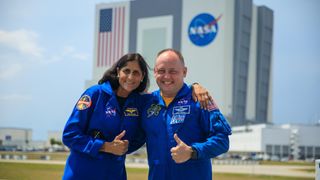
NASA astronauts Suni Williams (left) and Mike Fincke at NASA’s Kennedy Space Center in Florida, backdropped by the Vehicle Assembly Building. Williams is pilot of Crew Flight Test, while Fincke is both backup of Crew Flight Test and commander of first operational mission Starliner-1. (Image credit: NASA)
The astronauts of Starliner-1 are also deeply integrated in CFT’s training and mission operations. Starliner-1 commander and NASA astronaut Mike Fincke is serving as a backup on CFT; the other crew members for Starliner-1 are NASA’s Scott Tingle and the Canadian Space Agency’s Joshua Kutryk.
Given the delays in Starliner’s first astronaut test, several astronauts have either been shuffled from CFT and Starliner-1 to other missions, or reassigned between Starliner flights to meet operational requirements for NASA’s space station program. So, despite their extensive flight experience that eventually brought them on CFT, both Williams and Wilmore said the “stars aligned” to put them in these seats.
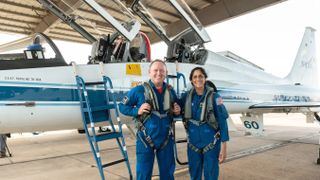
NASA Crew Flight Test astronauts Butch Wilmore and Suni Williams in front of a T-38 trainer at Ellington Field, nearby NASA’s Johnson Space Center in Houston. (Image credit: NASA/Robert Markowitz)
“It’s a very humble position to be in. I’m grateful,” Wilmore said of being one of the first to fly a new spacecraft. He cited the example of Apollo 16 astronaut and moonwalker John Young, a veteran of three space programs (Gemini, Apollo and space shuttle) who also was a Navy test pilot. Young’s long spacecraft resume included commanding the first space shuttle test flight, STS-1, in 1981.
“To be able to follow along and do something that he did is just very humbling,” said Wilmore, who briefly worked in the astronaut office at NASA’s Johnson Space Center at the same time as Young (who died at age 87 in 2018). “He was a test pilot. The astronaut’s astronaut, so to speak.”
“I think we just want to do our job right, and do the best that we can,” added Williams of the milestone mission. “Here we are on this spacecraft, for the first time that it will fly. But I think it’s just a result of doing your job and being ready to take any challenge that our country, and our office, is going to give us.”
Join our Space Forums to keep talking space on the latest missions, night sky and more! And if you have a news tip, correction or comment, let us know at: [email protected].
Elizabeth Howell (she/her), Ph.D., is a staff writer in the spaceflight channel since 2022 covering diversity, education and gaming as well. She was contributing writer for Space.com for 10 years before joining full-time. Elizabeth’s reporting includes multiple exclusives with the White House and Office of the Vice-President of the United States, an exclusive conversation with aspiring space tourist (and NSYNC bassist) Lance Bass, speaking several times with the International Space Station, witnessing five human spaceflight launches on two continents, flying parabolic, working inside a spacesuit, and participating in a simulated Mars mission. Her latest book, “Why Am I Taller?”, is co-written with astronaut Dave Williams. Elizabeth holds a Ph.D. and M.Sc. in Space Studies from the University of North Dakota, a Bachelor of Journalism from Canada’s Carleton University and a Bachelor of History from Canada’s Athabasca University. Elizabeth is also a post-secondary instructor in communications and science at several institutions since 2015; her experience includes developing and teaching an astronomy course at Canada’s Algonquin College (with Indigenous content as well) to more than 1,000 students since 2020. Elizabeth first got interested in space after watching the movie Apollo 13 in 1996, and still wants to be an astronaut someday. Mastodon: https://qoto.org/@howellspace
>>> Read full article>>>
Copyright for syndicated content belongs to the linked Source : Space.com – https://www.space.com/boeing-starliner-nasa-astronaut-crew-flight-test-launch-press-conference










